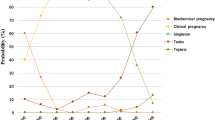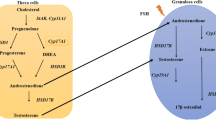Abstract
Purpose
To assesse circulating levels of Anti-Müllerian hormone (AMH) as a predictor of oocyte number and their potential to mature in vitro in both normo-ovulatory (NO) women and in women with Polycystic Ovary Syndrome (PCOS) undergoing in vitro maturation (IVM) treatments.
Methods
We prospectively studied NO women and women diagnosed with PCOS, (age range 21–39 years) underwent IVM treatments at our center. Serum AMH levels were quantified before each cycle and correlated to oocytes number, maturation and fertilization during in vitro maturation.
Results
104 NO and 30 PCOS IVM cycles were followed with retrieval of a total of 672 and 491 oocytes, respectively. In NO women, the serum AMH level positively correlated with the number of oocytes retrieved, (R = 0.6; P <0.0001) the number of M2 oocytes at 24 and 48 h (R = 0.4; P <0.01; R = 0.26 p < 0.007, respectively) and with the total number of M2 oocytes (R = 0.47; P < 0.0001). In the PCOS group, the serum AMH level positively correlated only with the number of oocytes retrieved (R = 0.43; P <0.03). Receiver operating characteristic (ROC) analyses showed that a cutoff AMH level of 1.56 (ng/ml) could identify patients with 5 or more oocytes at OPU with a sensitivity of 83 % and a specificity of 75 %. An AMH level of 1.63 (ng/ml) was the threshold for 5 or more matured oocytes (sensitivity = 81 %, specificity = 53 %).
Conclusions
Serum AMH may be used as a marker to identify candidates for IVM treatment in both NO and PCOS women.



Similar content being viewed by others
References
Barnes FL, Kausche A, Tiglias J, Wood C, Wilton L, Trounson A. Production of embryos from in vitro-matured primary human oocytes. Fertil Steril. 1996;65(6):1151–6.
Cha KY, Chung HM, Lee DR, Kwon H, Chung MK, Park LS, et al. Obstetric outcome of patients with polycystic ovary syndrome treated by in vitro maturation and in vitro fertilization-embryo transfer. Fertil Steril. 2005;83(5):1461–5. doi:10.1016/j.fertnstert.2004.11.044.
Chian RC. In-vitro maturation of immature oocytes for infertile women with PCOS. Reprod Biomed Online. 2004;8(5):547–52.
Child TJ, Abdul-Jalil AK, Gulekli B, Tan SL. In vitro maturation and fertilization of oocytes from unstimulated normal ovaries, polycystic ovaries, and women with polycystic ovary syndrome. Fertil Steril. 2001;76(5):936–42.
Dal Canto MB, Mignini Renzini M, Brambillasca F, Cepparo H, Comi R, Villa A, et al. IVM–the first choice for IVF in Italy. Reprod Biomed Online. 2006;13(2):159–65.
Das M, Gillott DJ, Saridogan E, Djahanbakhch O. Anti-Mullerian hormone is increased in follicular fluid from unstimulated ovaries in women with polycystic ovary syndrome. Hum Reprod. 2008;23(9):2122–6. doi:10.1093/humrep/den185.
Eldar-Geva T, Margalioth EJ, Gal M, Ben-Chetrit A, Algur N, Zylber-Haran E, et al. Serum anti-Mullerian hormone levels during controlled ovarian hyperstimulation in women with polycystic ovaries with and without hyperandrogenism. Hum Reprod. 2005;20(7):1814–9. doi:10.1093/humrep/deh873.
Fadini R, Comi R, Mignini Renzini M, Coticchio G, Crippa M, De Ponti E, et al. Anti-mullerian hormone as a predictive marker for the selection of women for oocyte in vitro maturation treatment. J Assist Reprod Genet. 2011;28(6):501–8. doi:10.1007/s10815-011-9589-6.
Fadini R, Dal Canto MB, Mignini Renzini M, Brambillasca F, Comi R, Fumagalli D, et al. Effect of different gonadotrophin priming on IVM of oocytes from women with normal ovaries: a prospective randomized study. Reprod Biomed Online. 2009;19(3):343–51.
Fadini R, Dal Canto MB, Renzini MM, Brambillasca F, Comi R, Fumagalli D, et al. Predictive factors in in-vitro maturation in unstimulated women with normal ovaries. Reprod Biomed Online. 2009;18(2):251–61.
Fanchin R, Schonauer LM, Righini C, Guibourdenche J, Frydman R, Taieb J. Serum anti-Mullerian hormone is more strongly related to ovarian follicular status than serum inhibin B, estradiol, FSH and LH on day 3. Hum Reprod. 2003;18(2):323–7.
Gnoth C, Schuring AN, Friol K, Tigges J, Mallmann P, Godehardt E. Relevance of anti-Mullerian hormone measurement in a routine IVF program. Hum Reprod. 2008;23(6):1359–65. doi:10.1093/humrep/den108.
Kedem-Dickman A, Maman E, Yung Y, Yerushalmi GM, Hemi R, Hanochi M, et al. Anti-Mullerian hormone is highly expressed and secreted from cumulus granulosa cells of stimulated preovulatory immature and atretic oocytes. Reprod Biomed Online. 2012;24(5):540–6. doi:10.1016/j.rbmo.2012.01.023.
La Marca A, Giulini S, Tirelli A, Bertucci E, Marsella T, Xella S, et al. Anti-Mullerian hormone measurement on any day of the menstrual cycle strongly predicts ovarian response in assisted reproductive technology. Hum Reprod. 2007;22(3):766–71. doi:10.1093/humrep/del421.
La Marca A, Malmusi S, Giulini S, Tamaro LF, Orvieto R, Levratti P, et al. Anti-Mullerian hormone plasma levels in spontaneous menstrual cycle and during treatment with FSH to induce ovulation. Hum Reprod. 2004;19(12):2738–41. doi:10.1093/humrep/deh508.
Le Du A, Kadoch IJ, Bourcigaux N, Doumerc S, Bourrier MC, Chevalier N, et al. In vitro oocyte maturation for the treatment of infertility associated with polycystic ovarian syndrome: the French experience. Hum Reprod. 2005;20(2):420–4. doi:10.1093/humrep/deh603.
Maman E, Meirow D, Brengauz M, Raanani H, Dor J, Hourvitz A. Luteal phase oocyte retrieval and in vitro maturation is an optional procedure for urgent fertility preservation. Fertil Steril. 2011;95(1):64–7. doi:10.1016/j.fertnstert.2010.06.064.
Mikkelsen AL, Lindenberg S. Benefit of FSH priming of women with PCOS to the in vitro maturation procedure and the outcome: a randomized prospective study. Reproduction. 2001;122(4):587–92.
Revised 2003 consensus on diagnostic criteria and long-term health risks related to polycystic ovary syndrome (PCOS). Hum Reprod. 2004;19(1):41–47
Scott L, Alvero R, Leondires M, Miller B. The morphology of human pronuclear embryos is positively related to blastocyst development and implantation. Hum Reprod. 2000;15(11):2394–403.
Seifer DB, MacLaughlin DT, Christian BP, Feng B, Shelden RM. Early follicular serum mullerian-inhibiting substance levels are associated with ovarian response during assisted reproductive technology cycles. Fertil Steril. 2002;77(3):468–71.
Tesarik J, Mendoza C, Testart J. Viable embryos from injection of round spermatids into oocytes. N Engl J Med. 1995;333(8):525. doi:10.1056/NEJM199508243330819.
Tremellen KP, Kolo M, Gilmore A, Lekamge DN. Anti-mullerian hormone as a marker of ovarian reserve. Aust N Z J Obstet Gynaecol. 2005;45(1):20–4. doi:10.1111/j.1479-828X.2005.00332.x.
Trounson A, Anderiesz C, Jones GM, Kausche A, Lolatgis N, Wood C. Oocyte maturation. Hum Reprod. 1998;13 Suppl 3:52–62. discussion 71–55.
Weenen C, Laven JS, Von Bergh AR, Cranfield M, Groome NP, Visser JA, et al. Anti-Mullerian hormone expression pattern in the human ovary: potential implications for initial and cyclic follicle recruitment. Mol Hum Reprod. 2004;10(2):77–83.
Acknowledgments
The authors are greatly indebted to Prof. Andrew Zbar of MEDEDIT, Sheba Medical Center for the English editing.
Author information
Authors and Affiliations
Corresponding author
Additional information
Capsule
The identification of cycles able to produce numerous oocytes will considerably improve the efficiency of IVM treatments. We would suggest that an AMH cut‐off concentration could guide the appropriateness of IVM therapy in selected cases, reducing the number of recruited cycles where suboptimal oocyte numbers are likely to be retrieved.
Rights and permissions
About this article
Cite this article
Kedem, A., Yerushalmi, G.M., Maman, E. et al. What is the optimal threshold of serum Anti-Müllerian hormone (AMH) necessary for IVM treatments?. J Assist Reprod Genet 30, 745–751 (2013). https://doi.org/10.1007/s10815-013-9996-y
Received:
Accepted:
Published:
Issue Date:
DOI: https://doi.org/10.1007/s10815-013-9996-y




